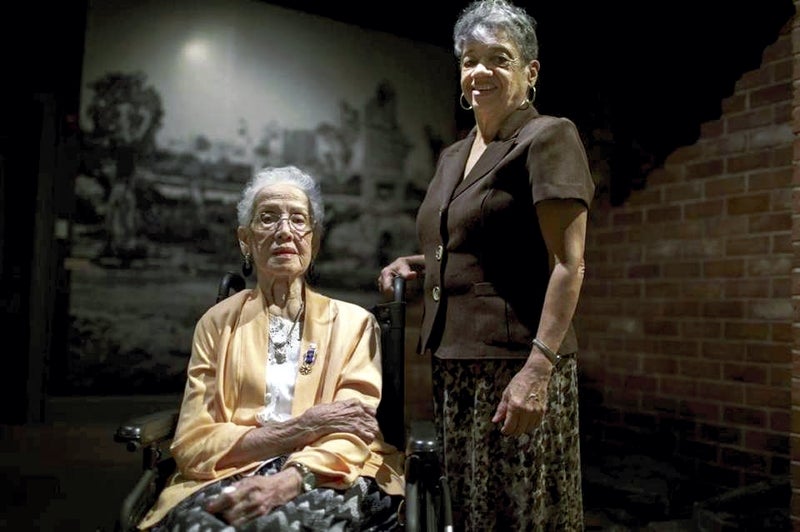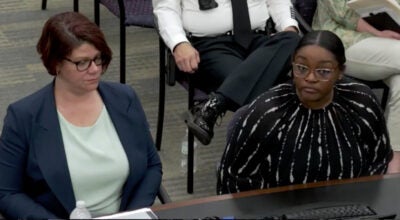The ‘Hidden Figure’ you still don’t know; she’s from Monroe
Published 12:00 am Monday, February 20, 2017

- Christine Darden (right) with Katherine Johnson at the Hampton (Va.) History Museum in August 2016. In the book “Hidden Figures,” on which the Oscar-nominated movie is based, the two former NASA mathematicians discuss the matter-of-fact way they approached their work during the space race and the new history about their careers as black female math whizzes in the Jim Crow South. CHET STRANGE New York Times
By Lawrence Toppman
The Charlotte Observer
MONROE (AP) — When her mother gave Christine Mann a doll, she cut it open to see how it talked.
When her brother broke the brakes on her bicycle, 5-year-old Christine fixed them with a coat hanger and a pair of pliers.
She spent elementary school weekends helping her dad work on the family car.
So nobody who knew her growing up in Monroe was surprised when she joined the National Aeronautics and Space Administration in 1967 as one of their “human computers” – or when she became an engineer who wrote more than 50 papers in her 40-year career.
You didn’t see her in the movie “Hidden Figures,” which focuses on the pioneering work of three African-American women: Katherine Johnson, Mary Jackson and Dorothy Vaughan, who helped get the Mercury astronauts into space in the early 1960s. But Margot Lee Shetterly’s book, the basis for that film, pays tribute to Christine Mann Darden, who landed at NASA five years afterward.
Her life is a journey of love. Love from parents who shepherded five siblings through college. Love of geometry, which put the world of math in perspective and opened a new world to explore. Love of Walter L. Darden Jr., the science teacher she married in 1963. And love of planes that split the sky with sonic booms, though those occurred less often and less damagingly after she researched them.
Few flights passed over her head as a child in western Union County. She turned 3 right after World War II ended in 1945, and the daughter of insurance agent Noah Mann and schoolteacher Desma Cheney was about to take off.
“My mother taught grades one through four at a two-room school, Liberty Hill,” she recalls. “I was the youngest of five children, so she stopped hiring a babysitter and took me with her when I was almost 4. She said, ‘You can go out and play,’ but there was nobody to play with. So I stayed in the classroom and learned.
“I entered second grade the following year at Winchester School. We might not have had the equipment white schools had, and we probably had used books, but the teachers were pretty good. They lived in the neighborhood, so they’d come by the house if you (needed help). If you did something wrong, everybody knew about it.”
Darden was the only child at home after she turned 8. She played softball and basketball in school, leading a life that was “fairly protected. People didn’t worry about locking their doors, and I don’t remember hearing about drug problems.
“I didn’t see white people much. Maybe every so often when we’d go downtown to shop, and a couple of them lived on the edge of Newtown, my neighborhood. But they weren’t part of my life.”
Racial tension heated up in the late 1950s, when firebrand Robert F. Williams headed Monroe’s NAACP chapter. By then, Christine attended Allen School, a Methodist boarding school in Asheville. She’d been sent there to escape not violence but temptation: “Older classmates were going to dances and parties, and I started bothering my parents about those things. That was it.”
A geometry class shifted the class valedictorian’s path from medicine to math and physics. She got a scholarship to Hampton Institute, where she participated in sit-ins before graduating in 1962, and briefly taught high school math. After marrying Darden, she became a research assistant in aerosol physics at Virginia State College, where she got a master’s degree. And then….
“I was applying to colleges for jobs, and someone said, ‘NASA was recruiting yesterday.’ I didn’t really know what engineers did. There was a Seaboard Air Line Railroad roundhouse in Monroe; to us, an engineer drove a train. I didn’t know until I got to NASA how close my applied mathematics were to what theoretical engineers did. A lot of the men there had applied math degrees.”
Now she entered a world not too different from the one in the Oscar-nominated “Hidden Figures.” She’s seen it “around seven times — several times with schoolchildren — and offered comments afterward. I have spoken mostly about why they should take math and science courses. I like Dorothy Vaughan’s quote: ‘Learn all you can and make yourself valuable to somebody.’ “
That’s what Darden did. The future held small calculators that could do square roots and trigonometry, but she and her colleagues did that manually: “Computers were not everyday things, so final figures for reports had to be done by hand. We had to use a French curve, a kind of plastic rule in different shapes that gave you a smooth curve when you plotted data on a graph.”
She eventually found her niche as leader of the Sonic Boom Team, a subsidiary of the High Speed Research Program. Sonic booms were the sky-cracking delight of every adventurous child but the despair of homeowners who reported shattered windows or cracked sheet rock and complained about noise pollution. (Booms occur as supersonic craft fly faster than the speed of sound.)
Darden learned how airplane designs affected sonic booms, how flight paths altered them, how atmospheric conditions influenced them, how people on the ground perceived them, what happened to the ozone layer if planes created booms at high altitudes.
Race, she says, wasn’t much of a factor in her NASA career. But gender was.
“A young black fellow was hired the same summer as I …. During the five years I was in the computer pool, he was promoted twice in the analysis and computation division – people writing programs for the entire field – and I had not been promoted at all. I asked, ‘Why are males coming here with the same background I have and being put into computation, while females have dead-end jobs?’
“My boss said, ‘Nobody’s ever asked that before. A lot of women trained as engineers would quit to raise children, and they would waste their education.’ But he transferred me to an engineering section, which meant I was approved for … educational leave.” George Washington University offered a program on the base, and she earned a Ph.D. in 1985 through night classes. (By the way, she raised three children.)
She also earned colleagues’ respect: “When I started my classes, that was with all men. A lot of the meetings were with all men. When I traveled, it was with all men. But it worked out well.”
Darden stayed flexible. When the government killed supersonic research in the 1980s, she went into classified operations; when funding came back, she helped get the supersonic program up to speed. She heard money would not be renewed in the mid-’90s, trained for Senior Executive Service and continued to direct research at Langley. She ended up overseeing a combined office of public affairs, legislative affairs and education.
At 74, she doesn’t second-guess a life that turned out well. She does, though, remember an option that might’ve knocked her out of NASA’s orbit forever.
“The day I took my teaching job in Virginia, I had a job offer from the Charlotte school system,” she says. “I always wonder what would have happened had I accepted it.”



